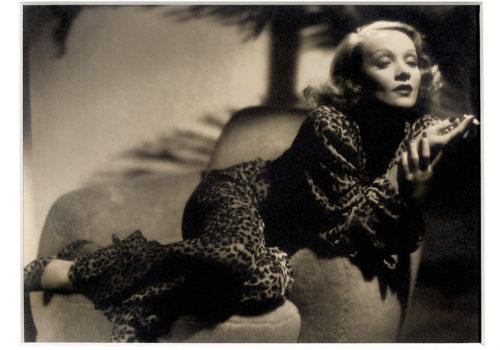Featuring 250 photographs taken from 1906 to 1978, Play the Part: Marlene Dietrich at the International Center of Photography (ICP) examines the multifaceted evolution of Marlene Dietrich’s (1901–1992) public persona. The exhibition features photographs by well-known artists such as Cecil Beaton, Irving Penn, and Edward Steichen as well as photographers with whom Dietrich collaborated repeatedly throughout her life, including the noted Hollywood photographer George Hurrell, Eugene Robert Richee, and William Walling Jr. Previously unpublished images, snapshots, and other works complement the formal portraits and studio images that have come to represent Dietrich, illustrating the true complexity of her life. Assembled by collector Pierre Passebon, this exhibition marks the first time his noted collection will be shown in the United States.
Peter Riva, Dietrich’s grandson, wrote the following text.
We all know Marlene was unique. Unique as a performer, unique as a trailblazer, unique in her fashion sense, and certainly unique in her relationships. All these disciplines came together, for her, when assessing and approving photographers. Oh, sure, there were snaps taken of her, candid images, that she enjoyed – often she even complimented whoever was lucky enough to take the snapshot. But these were not photographs, not professional, artistic, stimulating images. Professional photography was an art form she learned, perfected her knowledge of, accepted as necessary, and of which she completely mastered into her control.
How can one identify Marlene’s appreciation of the best, most intelligent, most capable, photographers? By reviewing those images she cherished and kept — and separating out those she didn’t care for as much. Oh, yes, she kept images that were only useful for work reference, especially Whitey Schaefer, Paul Cwojdzinski, Hyman Fink, Wm. Walling, Don English – the way a dress shimmered, or the stance she took, or how the lighting did or didn’t work. But those were part of her craft perfection workload, not appreciation of the artist. And there were images she kept, to remind herself of who she did not want to work with; photographers whose vision conflicted with the entity she had created. She kept those samples, often marked up with comments like, “Never again!” Avedon, Hurrell, Armstrong Jones, and others, all great in their own right, she knew they didn’t see what she created and perfected. They wanted to refashion her, create something of their own choosing. Dietrich was not a model to be sculpted, but seen as the refined product she had created, inside and out.
With images that transcended the mundane, saw the reality, she looked to mastery by the photographer. Then, her own self-worth, at times her own created image, did not matter. Their craft, their expertise for framing, posing, lighting, focus – these mattered, these were her unique guideposts to excellence. How else can you explain why Penn’s corner series portrait of her, which is hardly flattering of the woman, was kept, always, in her private collection? Or Milton Greene’s table shots? Or von Sternberg’s Scarlett Empress stills for Paramount (which he lit, posed her, and did everything except push the button – he let whoever was Paramount’s staff photographer – likely Richee — handle the camera mechanics)? Or Bill Claxton’s dressing room images? Or Roddy McDowell’s stage image? Or Cornell Lucas’ shot of her sitting on her luggage in 1951? Or Alex Liberman’s 1950s images? Or Horst’s Vogue images? Or Louise Dahl-Wolf’s image of her in front of a Spanish poster? Or Beaton’s English porcelain doll series? Or Steichen’s wing-back chair series? She kept these and so many more, in her apartment in NY, and they now reside in the Marlene Dietrich Collection Berlin.
I never heard her speak ill of a photographer, images at times, yes. The person? No. She knew they were workers, she had respect. And that respect often translated into ensuring a good photographer got more work even if elsewhere. Bill Claxton told me she introduced him to West End producers who hired him on her say-so. Rarely, when a greatness in the photographer was exhibited, when a generosity of image was produced, then her admiration was both transparent and at times overwhelming. Arthur Penn once told me that she was one of the most difficult subjects he ever photographed, not because she was difficult, but because her personality and intelligence, not her looks, overwhelmed the sessions. Alex Liberman said almost the same thing, explaining why he only ever took unposed snapshots of her – and yet those images are pure magic. I think Meri von Sternberg summed it up for me, explaining that her husband always said Marlene was his most difficult of subjects before the camera, “Because her excellence demanded even more excellence from him and the whole crew during filming.”
I guess that’s the point of Marlene’s art photographic record, layers on layers of excellence, each multiplying the other, creating something unique, just as she was.
Peter Riva
Play the Part : Marlene Dietrich
September 29, 2023 – January 8, 2024
The International Center of Photography (ICP)
79 Essex Street
New York, NY 10002
www.icp.org
















